Exploring the Flavors of Spanish Cuisine with Classic Dishes
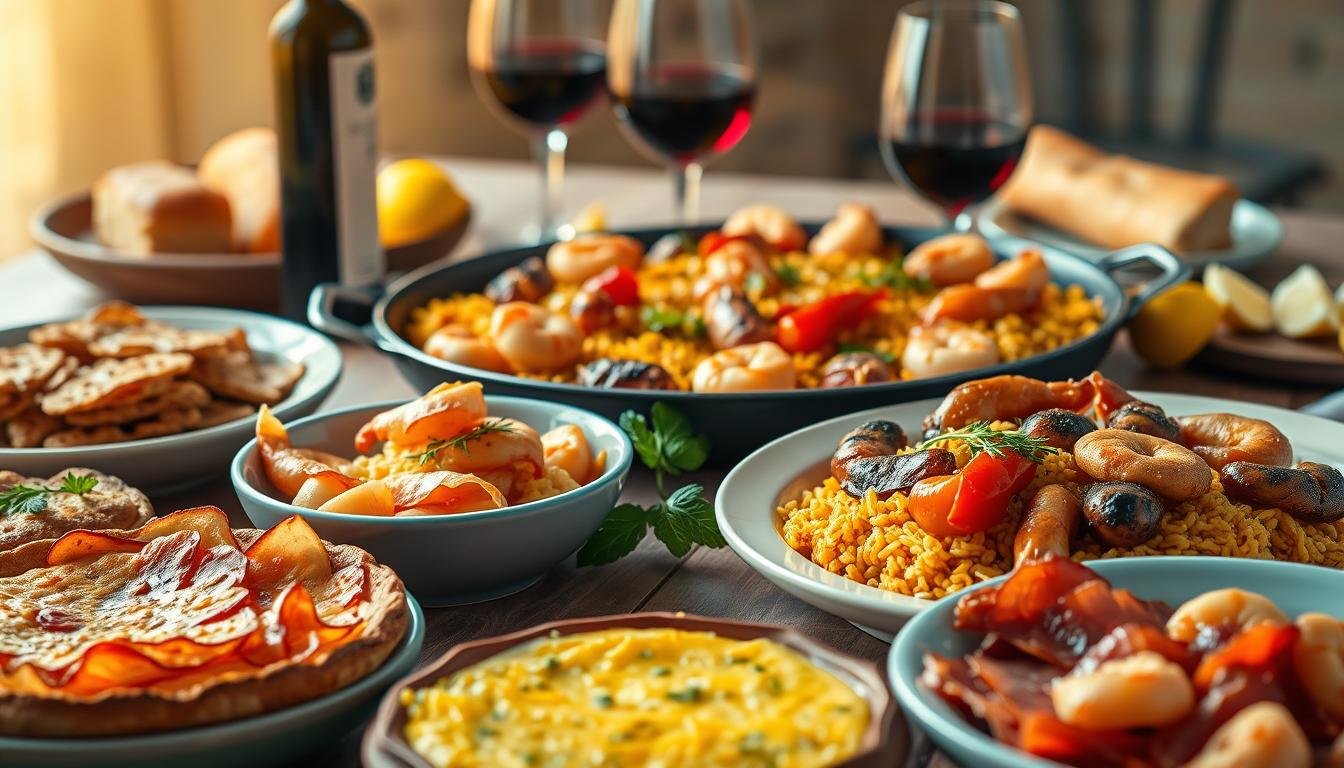
Do you remember the last time you found a flavor that amazed you? For me, it was my first taste of saffron paella in Valencia. It was a magical moment. Authentic Spanish dishes take you on a journey of colors, stories, and love for sharing meals.
Spanish cuisine is more than just food; it’s a way to feel Spain’s soul. Each dish tells stories of old trade paths, empires, and strong local traditions. It celebrates fresh, local ingredients. From cool gazpacho in summer to sharing tapas with friends, every dish has its own story.
Let’s explore this world where every bite invites you to discover Spanish flavors and traditions. Are you ready to start this food adventure with me?
Key Takeaways
- Authentic Spanish dishes are deeply rooted in regional traditions and history.
- Classic Spanish food, such as paella, tapas, and gazpacho, offers a vivid reflection of Spain’s cultural and geographic diversity.
- Each traditional Spanish meal celebrates local, seasonal ingredients and communal eating.
- The vibrant flavors of Spanish cuisine can transport you to Spain’s sun-drenched landscapes and bustling markets.
- Exploring Spanish cuisine is a journey into the heart of Spanish way of life.
Introduction to Spanish Cuisine
Spanish cuisine takes us on a journey of flavors, history, and tradition. It’s like opening a time capsule filled with ancient influences!
Historical Influences on Spanish Cooking
Let’s explore Spanish food history. The Romans introduced ways to preserve meats like salting and curing. These methods are key in Iberian cuisine today.
The Moors brought exotic spices, adding depth to Spanish dishes. Imagine the mix of Mediterranean flavors with these historic spices—it’s a dream!
Key Ingredients Found in Spanish Dishes
What makes Spanish dishes special? Saffron, known as the golden jewel of Spain, adds a unique flavor. Jamón ibérico, a cured ham, is a national favorite.
Seafood is also a big part of Spanish cuisine, thanks to the country’s long coastline. And olive oil, the heart of Mediterranean cuisine, is the base of most Spanish dishes.
When making paella or tapas, these ingredients create layers of flavor. It’s amazing how history shapes such a rich culinary identity.
Popular Spanish Dishes to Try
Spanish cuisine has many dishes that are loved by all. These dishes are full of flavor and color. They make your meals special. Let’s explore some must-try Spanish dishes.
Paella: A Signature Spanish Dish
Paella is a classic dish from Valencia. It’s a mix of saffron rice, prawns, mussels, chicken, and chorizo. The crispy rice at the bottom is called *socarrat*. It’s perfect for family gatherings or casual dinners.
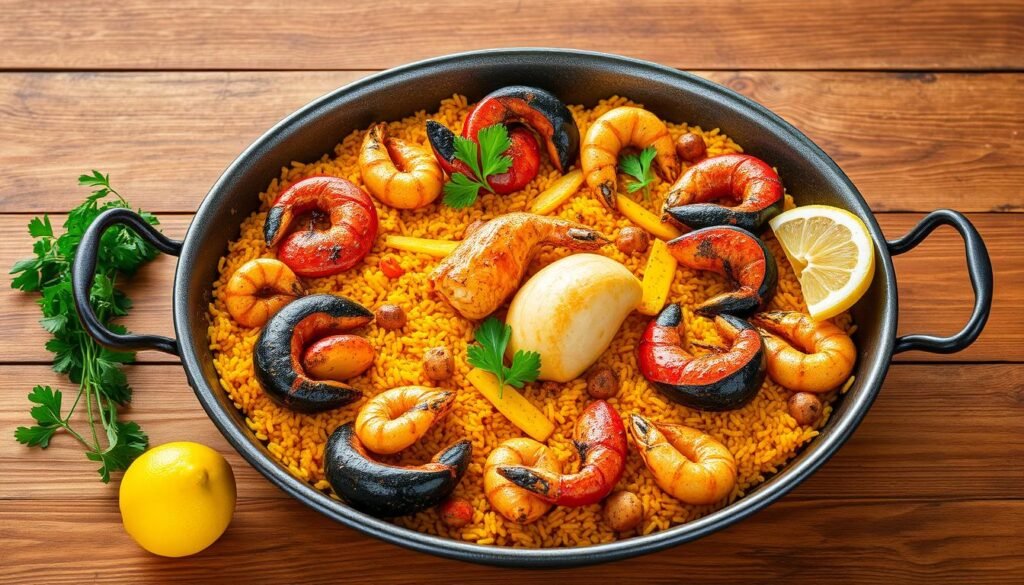
Tapas: Small Plates, Big Flavors
Tapas are more than appetizers. They are a way of life. Imagine trying Patatas bravas, Gambas al ajillo, or Jamón ibérico at a Spanish bar. Each dish is small but full of flavor.
Tapas are all about sharing and enjoying many flavors together. It makes every meal a special event!
Gazpacho: The Refreshing Cold Soup
Gazpacho is perfect for hot summer days. It’s made with tomatoes, cucumbers, bell peppers, onions, garlic, and sherry vinegar. It’s served cold and is a refreshing part of Spanish meals.
Gazpacho is light, refreshing, and healthy. It’s a must-try for anyone exploring Spanish cuisine.
Here is a quick comparison of these iconic dishes:
| Dish | Main Ingredients | Region | Occasion |
|---|---|---|---|
| Classic Spanish Paella | Rice, saffron, seafood or meats | Valencia | Family gatherings, festive occasions |
| Tapas Cuisine | Varies (potatoes, shrimp, cured meats) | Nationwide | Casual dining, social events |
| Gazpacho Recipe | Tomatoes, cucumbers, bell peppers | Andalusia | Hot summer days |
Regional Varieties of Spanish Cuisine
Exploring Spanish food is like a fun adventure! Each region has its own special tastes and dishes. These dishes show off the area’s culture, history, and local foods. Let’s explore the tasty world of Spanish regional cuisines!
Andalusian Specialties
Andalusian food is vibrant and key to Spanish cuisine. This southern area is famous for its cool gazpacho and tasty grilled fish. The fresh ingredients and rich history make Andalusian dishes a must-try!
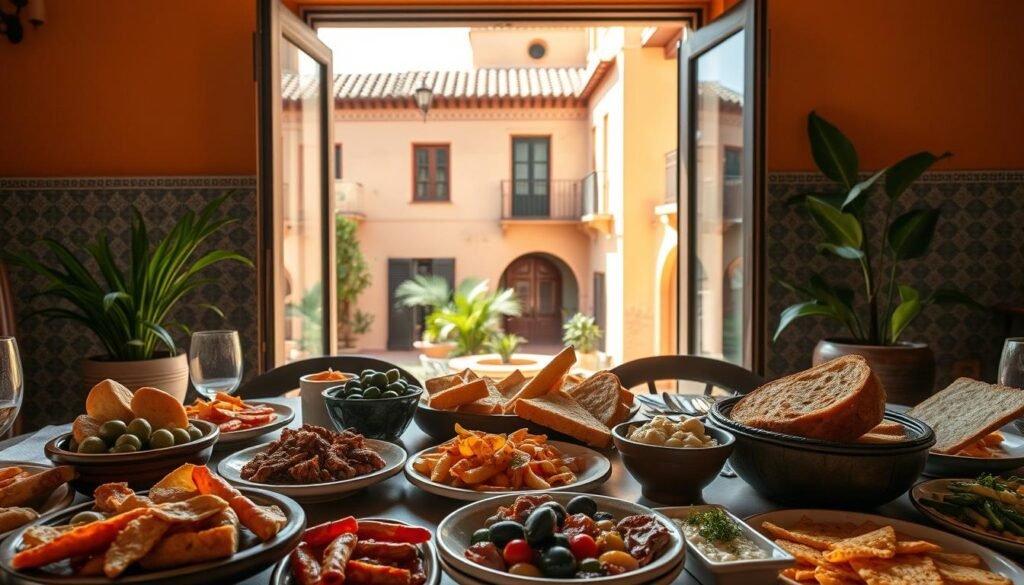
Catalan Culinary Traditions
Catalan food is all about the Mediterranean diet. It focuses on fresh veggies, seafood, and meats. My favorite is escalivada, a tasty mix of roasted veggies. Catalonia’s food is all about keeping it simple and using the best ingredients, making every meal special!
Basque Country Delights
The Basque country has a wide range of foods. You’ll find everything from bacalao a la vizcaína to hearty meat dishes. The famous pintxos, small snacks, are also a must-try. They pack big flavors into small bites.
Galician Seafood Dishes
Galicia is a paradise for seafood lovers. With its long coastline, it offers some of Spain’s freshest seafood. Try pulpo a la gallega (Galician-style octopus) for a taste of the sea. Galician seafood is simple yet irresistible!
Essential Cooking Techniques in Spanish Cuisine
Spanish cuisine is known for its rich flavors and diverse cooking techniques. Let’s explore the key Spanish cooking methods. They bring out the true taste and texture of traditional dishes.
Sautéing and Frying
Sautéing and frying are key techniques in Spanish cooking. For dishes like gambas al ajillo (garlic shrimp) and churros, using good olive oil is important. Sautéing in olive oil makes flavors pop. Frying adds a nice crunch.
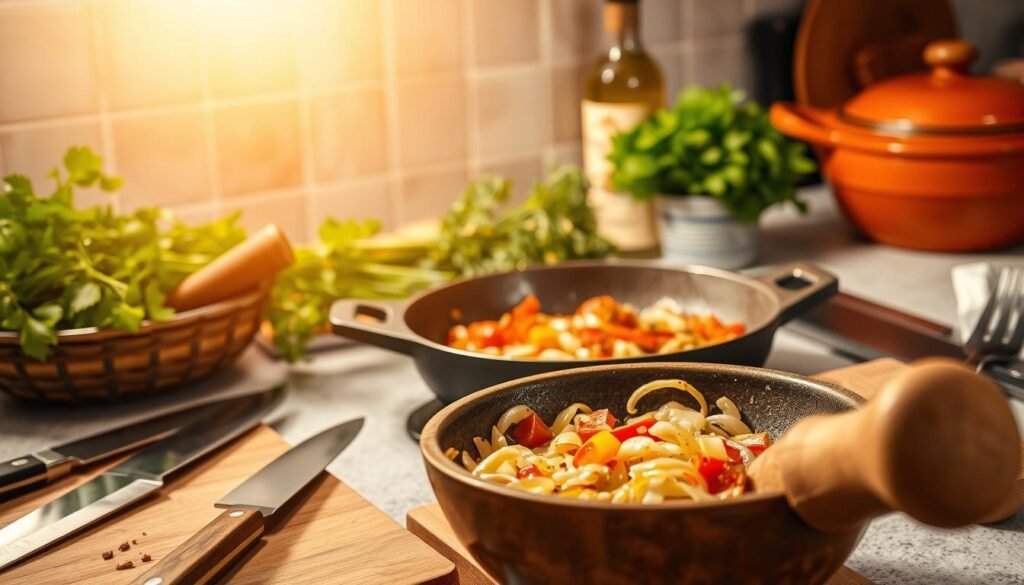
Slow Cooking and Stewing
Slow cooking and stewing are vital in Spanish cooking. Dishes like fabada asturiana (bean stew) and cocido madrileño (Madrid stew) need slow simmering. This method creates deep, comforting flavors.
Grilling and Roasting
Grilling and roasting are Mediterranean methods that highlight natural flavors. Grilling is great for seafood and veggies. Roasting is ideal for Pollo al ast (roast chicken). Both methods give a smoky, tasty flavor.
The Role of Garnishes and Presentation
Let’s explore the colorful side of Spanish cuisine. How a dish looks on the plate is just as important as its taste. Fresh herbs and spices add a burst of color and flavor. Let’s take a closer look!
Herbs and Spices Commonly Used
In Spanish cooking, some herbs and spices are always key. Fresh parsley adds a bright green that invites you to try it. Paprika, with its smoky taste, also adds a beautiful red color.
| Herbs | Spices |
|---|---|
| Parsley | Paprika |
| Thyme | Saffron |
| Rosemary | Cumin |
| Basil | Nutmeg |
The Art of Plating Spanish Dishes
Have you ever seen a beautifully plated gazpacho or tapas? Spanish cuisine focuses on color, texture, and flavor. A golden tortilla española with fresh herbs is truly mouthwatering.
The aim is to make dishes both beautiful and delicious. From arranging pimientos de padrón to displaying Iberian ham, presentation is key. It’s all about making food look as good as it tastes. Trust me, presentation matters a lot!
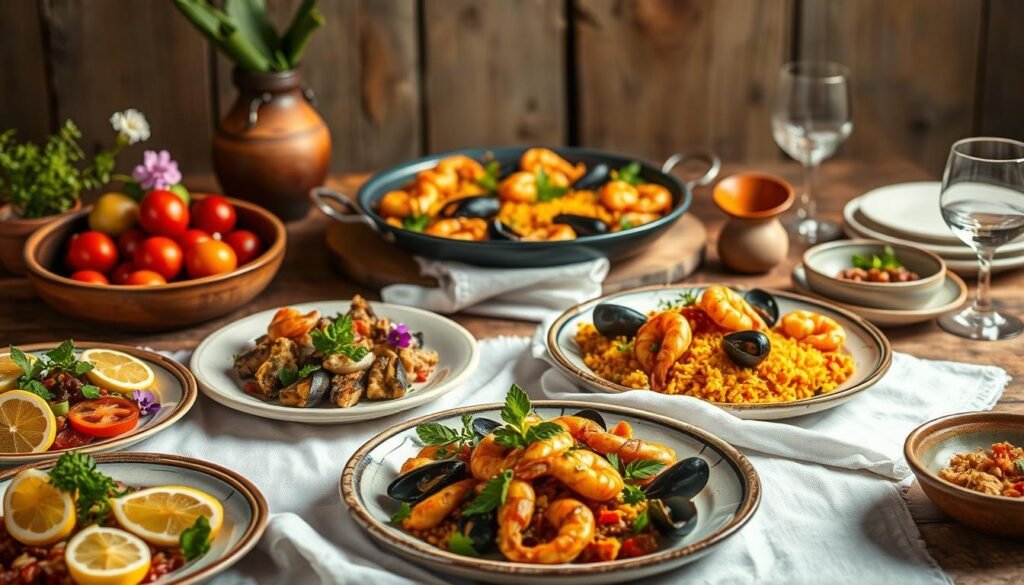
Spanish Wines and Their Pairings
Spanish wines are as diverse and vibrant as the country’s culinary portfolio! Whether it’s a rich Rioja red wine or a crisp Rías Baixas white wine, there’s something for every palate. Cava, Spain’s sparkling gem, adds an effervescent flair to any occasion. Let’s dive into the world of Spanish wines and discover their perfect pairings!
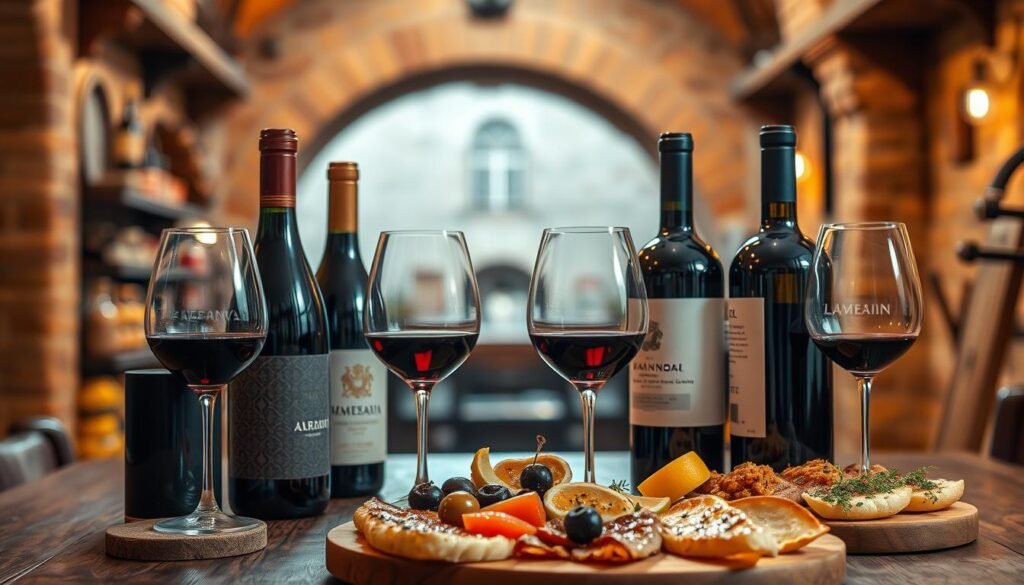
Red Wines from Rioja
Rioja red wines are known for their bold flavors and aging potential. These wines have a rich profile, often with notes of red fruit, vanilla, and spices. They pair well with grilled meats, artisan cheeses, and hearty stews. Imagine enjoying a juicy steak with a glass of deeply colored Rioja – it’s delightful!
White Wines from Rías Baixas
Rías Baixas white wines, made mainly from the Albariño grape, are refreshing for warm-weather meals. They burst with citrus, green apple, and floral notes. They’re great with seafood. Picture a plate of fresh oysters or grilled shrimp with a glass of Rías Baixas white wine – it’s bliss!
The Rising Popularity of Cava
Cava, Spain’s answer to champagne, has become very popular. It’s known for its fine bubbles and toasty flavors. Cava is versatile, perfect for toasts, celebrations, or as an aperitif. It pairs well with many foods, from tapas to light salads. The elegance of Cava makes it a favorite among wine lovers.
In conclusion, exploring Spanish wines is a journey of taste and tradition. From the robust Rioja red wines to the crisp Rías Baixas white wines and the effervescent Cava, there’s a Spanish wine for every dish and occasion. Knowing these wines and their pairings can make any meal a delightful Spanish-like experience!
Vegetables and Legumes in Spanish Cooking
Vegetables and legumes are stars in Spanish cooking. They add flavor and health benefits. Let’s explore the world of vegetables and legumes in Spain!
Celebrating the Mediterranean Diet
The Mediterranean diet is famous for its heart-healthy ingredients. It uses fresh, seasonal vegetables and legumes. In Spain, dishes like espinacas con garbanzos show the diet’s rich flavors and health benefits. These meals are tasty and good for you!
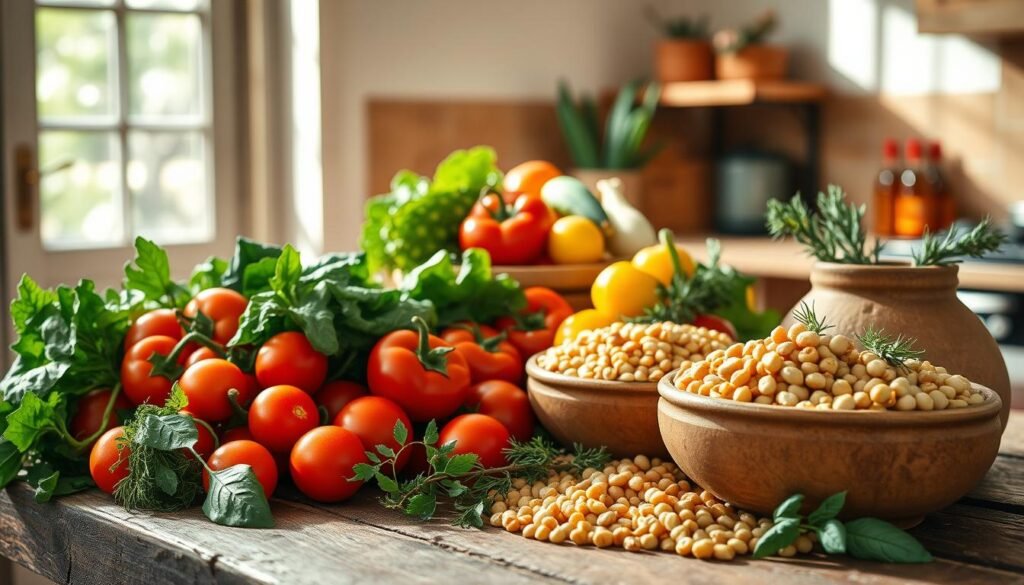
Popular Vegetable Dishes
Spanish vegetable dishes are a treat for the senses. They range from sautéed greens to roasted vegetables. Some famous recipes include:
- Pisto: A Spanish ratatouille with tomatoes, peppers, and zucchini.
- Coliflor rebozada: Fried cauliflower that’s crispy outside and tender inside.
- Menestra de verduras: A mixed vegetable stew with artichokes, peas, and carrots.
- Escalivada: A grilled vegetable platter of eggplant, pepper, and onion, served with olive oil.
These recipes celebrate vegetables in simple yet delicious ways. They use cooking techniques that bring out the best in the ingredients. Every bite is a joy.
| Dish Name | Main Ingredients | Cooking Method |
|---|---|---|
| Pisto | Tomatoes, Peppers, Zucchini | Sautéing |
| Coliflor Rebozada | Cauliflower | Frying |
| Menestra de Verduras | Artichokes, Peas, Carrots | Stewing |
| Escalivada | Eggplant, Pepper, Onion | Grilling |
Looking to try the Mediterranean diet or new Spanish recipes? Start with these vegetable dishes. Happy cooking!
Sweet Treats: Spanish Desserts
Spanish desserts are a treat that will impress your taste buds. They are the perfect end to any Spanish meal. From the crispy churros with chocolate to the smooth flan, these desserts show Spain’s culinary skill. Are you ready to try them?
Churros and Chocolate
In any Spanish café, you’ll see people enjoying churros with chocolate. These sweet, fried dough sticks are coated in sugar. They’re served with a thick, rich chocolate sauce. Dipping them in chocolate is a special tradition.

Flan: The Creamy Custard
The flan is another Spanish dessert favorite. It has a caramel-coated outside and a creamy inside. The secret to a great Spanish flan recipe is its smooth texture and caramel sweetness. Making flan might seem hard, but it’s worth it!
Conclusion: Embracing Spanish Cuisine at Home
Starting to cook Spanish food at home is a tasty adventure. It will make your taste buds happy and impress your guests! We’ll give you tips to make easy Spanish recipes that taste like they’re from Spain.
You’ll learn how to pick the best ingredients and use important cooking techniques. This will help you make authentic Spanish dishes in your kitchen.
Tips for Cooking Spanish Dishes
Begin by using fresh, high-quality ingredients. Look for saffron, olive oil, and fresh seafood. These are key for real Spanish flavors.
Don’t be shy to try herbs and spices like smoked paprika and garlic. They can make your dishes amazing! Also, try slow cooking for stews and sautéing for tapas. Remember, the more you practice, the better you’ll get!
Resources for Authentic Recipes
To get better at cooking Spanish dishes, use trusted resources. Cookbooks by famous Spanish chefs like José Andrés are great. Online platforms also have guides and videos to help you.
These resources will help you learn more recipes and understand Spanish cuisine’s traditions. You’ll be cooking authentic Spanish dishes in no time!